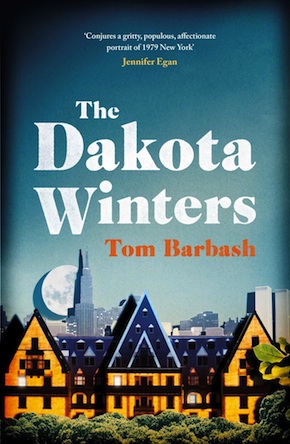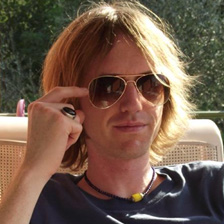Just sittin’ here doin’ time
by Brett Marie
“Deft, funny, touching and sharply observed.” Michael Chabon
When my mother got home, the four of us would head out to dinner, and twice my sister, Rachel, joined us. It felt sometimes like it was the old days again, and other times a little strained, as though we were in a play about a family who all hold secrets from one another. In the past, Buddy had largely orchestrated the conversation, and now he picked his spots, and at times tuned the rest of us out. My mother would ask, “What’s up, kiddo?” And he’d raise his eyebrows and say, “Wouldn’t you like to know.”
I suppose it sounds like faint praise to call Tom Barbash’s new novel The Dakota Winters a ‘quiet’ book. Few readers will rush to read a story for its ‘low-stakes family drama’, or its ‘mild-mannered’ cast. I wish there were a way I could generate excitement about this story of fathers and sons, celebrity and artistic inspiration. Sadly, any attempt I might make to dial up the tension in Barbash’s prose, any effort I might expend to make his plot sound like some unputdownable wild ride would be horribly dishonest.
Besides, such phony enticements would ignore the very thing that makes The Dakota Winters the extremely satisfying read that it is. It was precisely the quiet energy that hums beneath the surface of protagonist Anton Winter’s day-to-day activities in the last twelve months of his famous neighbour John Lennon’s life that kept the book in my hand and the smile on my face throughout its 300-odd pages.
We begin in January of 1980, with twenty-three-year-old Anton’s return to New York’s Upper West Side, after a bout with malaria cuts short his stint with the Peace Corps in Gabon. Waiting for him in the family home in the landmark Dakota apartment house is his father Buddy Winter, a renowned comedian and former TV talk-show host who is remembered most vividly for having recently walked off his show in an apparent nervous breakdown. Buddy wants to reconnect with his son, but he’s also anxious for Anton, who grew up largely on-set and had an education in how a talkshow works, to help him in his bid to return to the late-night airwaves.
The story’s central conflict is clear from the start: Anton, who has already tried to strike out on his own, doesn’t relish the role of assistant to his old man. But Barbash has no appetite for the usual dysfunctional family tropes. Buddy walked out on his family as well as his show, spending months travelling alone, but by the time we meet them all he has managed to stitch himself back into the family unit. The titular Dakota Winters are a mostly loving clan of five, who accompany each other to the various to-do events of the day (the 1980 Winter Olympics in nearby Lake Placid, a Ted Kennedy presidential campaign fundraiser), support each other through a period of emotional healing and financial hardship, and seem to genuinely enjoy each other’s company. Anton seems more pleased than dismayed when network execs interested in the show catch wind of his budding friendship with the family’s reclusive fellow Dakota tenant John Lennon, and he’s enlisted to feel John out about a possible reunion with his old band mates the Beatles on Buddy’s programme.
The arc of Lennon’s last year is a perfect parallel to Buddy’s story. While Buddy patches together the final pieces of his professional and personal lives , Lennon begins his own creative rebirth after a self-imposed exile.”
Anton’s relationship with a fictionalised Lennon is Barbash’s most ambitious creative leap. It’s a double-edged sword to have a legend like John Lennon wandering through the pages of The Dakota Winters. Lennon and his wife Yoko Ono are like two celebrity guests at a party filled mostly with unknowns; you might spend hours having perfectly stimulating conversations with complete strangers, but you’ll spend the night wondering where Those Two are and what they’re up to. To make a supporting character out of a cultural icon, the author must walk quite a tightrope, balancing readers’ expectations of the witty and sensitive Beatle John against the far more prickly personality found in more than one Lennon biography (among them Albert Goldman’s exhaustive exercise in character assassination The Lives of John Lennon). It’s uncanny how completely he succeeds: like moviegoers watching a great actor embody a role in a celebrity biopic, readers might have to remind themselves at times that what they’re viewing isn’t the real deal (though some might be shocked to learn that the novel’s most unlikely chapter, in which Lennon takes a sea voyage to the tropics and ends up piloting his yacht through a life-threatening squall, is based on real events).
The arc of Lennon’s last year is a perfect parallel to Buddy’s story. While Buddy plots his return to network television, patching together the final pieces of his professional and personal lives after having shattered both by his own hand, Lennon begins his own creative rebirth after a self-imposed exile inside the Dakota. And here the book’s quiet tone once again proves entirely fitting. For both men, the great dramas of their lives are in their backstories. At the height of the Beatles’ fame, Lennon’s life was filled with the blare of guitar and drums and the screams of rabid fans. Even after the band’s break-up put a lid on that noise, his inner demons kept up a din of their own (most notably during his famously turbulent ‘Lost Weekend’ in the mid-seventies). Similarly (though less spectacularly), Buddy’s sudden flight from fame has passed, and its uproar has died down. The time for melodrama is over. As Lennon himself sings in a standout track from that year: “No longer ridin’ on the merry-go-round/I just had to let it go.”
A lesser writer might have given into the temptation to amp up the stakes. Father-son tension? Why not bring it to a boil, and have Anton take a swing at his dad to keep the pages turning? Eighties’ New York? There’s nothing like sprinkling some cocaine around to pick up the pace when the plot sags. Barbash could have relied on these or a dozen other false pay-offs to move his story forward. Thank goodness he’s smarter than that, and relies on a different set of spurs: among other things, a sophisticated sense of humour (Anton’s narration benefits from the cool wit he inherits from his father), and a cast of characters both as deep and as likeable as the real-life figures who share the page with them. And what a relief it is to find a book that doesn’t take its readers hostage with threats of violence or contrived family crises, one which delights more in the nuances of lives quietly lived.
Barbash takes pleasure tapping into the star’s sense of renewal as he approached the sessions for his comeback album… but the knowledge of Lennon’s approaching fate laces every hopeful passage with foreboding.”
Of course, Barbash does benefit from one device that’s built into his premise: every reader who picks up The Dakota Winters will know that one of its main characters is a marked man. As the last year of John Lennon’s life rolls inexorably on, the spectre of his murder hangs over every plot development. Barbash takes obvious pleasure tapping into the star’s well-documented sense of renewal as he approached the sessions for his comeback album Double Fantasy. That infectious optimism spills into Anton and Buddy as they plan Buddy’s concurrent return to the spotlight. But for any reader in 2019, the knowledge of Lennon’s approaching fate laces every hopeful passage with a sense of foreboding. Barbash can talk all he wants about the good times, and tease us with the music fan’s fantasy of a Beatles reunion on Buddy’s talk-show stage; without lifting a finger, he has us wondering how the gunshots that felled the real-life Lennon will ricochet into the Winters’ fictional careers and aspirations.
Therein lies Barbash’s final challenge: navigating past that one great and horrible act – inescapable from page one – that would threaten the book’s fragile quietude. Lennon’s murder on 8 December 1980 was unequivocally tragic. But Barbash recognises that what happens to the rest of his cast needn’t be. There is room in this big world for both triumph and tragedy, but most stories if they’re true to life will fall somewhere in the wide spectrum in between. And perhaps it’s the greatest strength of literary fiction as a genre, that it can keep a reader rapt in this middling territory where thrillers and romances would sputter and stall. Barbash’s greatest achievement might be that, to the last page, even in the aftermath of an act of brutality that in truth has always been at his story’s heart, he manages to maintain his nuanced mood, and even cap his piece with a grace note of quiet joy.
 Tom Barbash is the author of the award-winning novel The Last Good Chance, the Folio Prize shortlisted story collection Stay Up With Me and the New York Times non-fiction bestseller On Top of the World. His stories and articles have been published in Tin House, McSweeney’s, VQR and other publications, and have been performed on US National Public Radio. Raised in Manhattan, he currently lives in California. The Dakota Winters is published in hardback, eBook and audio download by Simon & Schuster.
Tom Barbash is the author of the award-winning novel The Last Good Chance, the Folio Prize shortlisted story collection Stay Up With Me and the New York Times non-fiction bestseller On Top of the World. His stories and articles have been published in Tin House, McSweeney’s, VQR and other publications, and have been performed on US National Public Radio. Raised in Manhattan, he currently lives in California. The Dakota Winters is published in hardback, eBook and audio download by Simon & Schuster.
Read more
@TomBarbash
Author portrait © Sven Wiederholt
 Brett Marie, also known as Mat Treiber, grew up in Montreal with an American father and a British mother and currently lives in Herefordshire. His short stories and other writing have appeared in publications including The New Plains Review, The Impressment Gang, PopMatters and Bookanista, where he is a contributing editor. He recently completed his first novel The Upsetter Blog.
Brett Marie, also known as Mat Treiber, grew up in Montreal with an American father and a British mother and currently lives in Herefordshire. His short stories and other writing have appeared in publications including The New Plains Review, The Impressment Gang, PopMatters and Bookanista, where he is a contributing editor. He recently completed his first novel The Upsetter Blog.
Facebook: Brett Marie
@brettmarie1979

